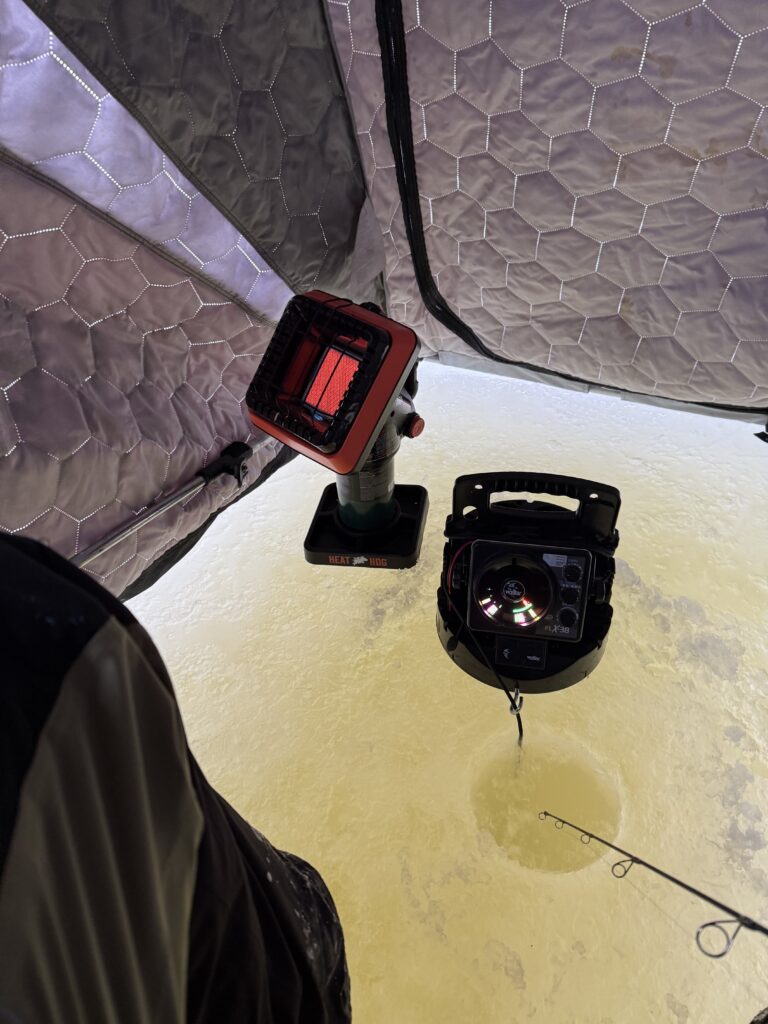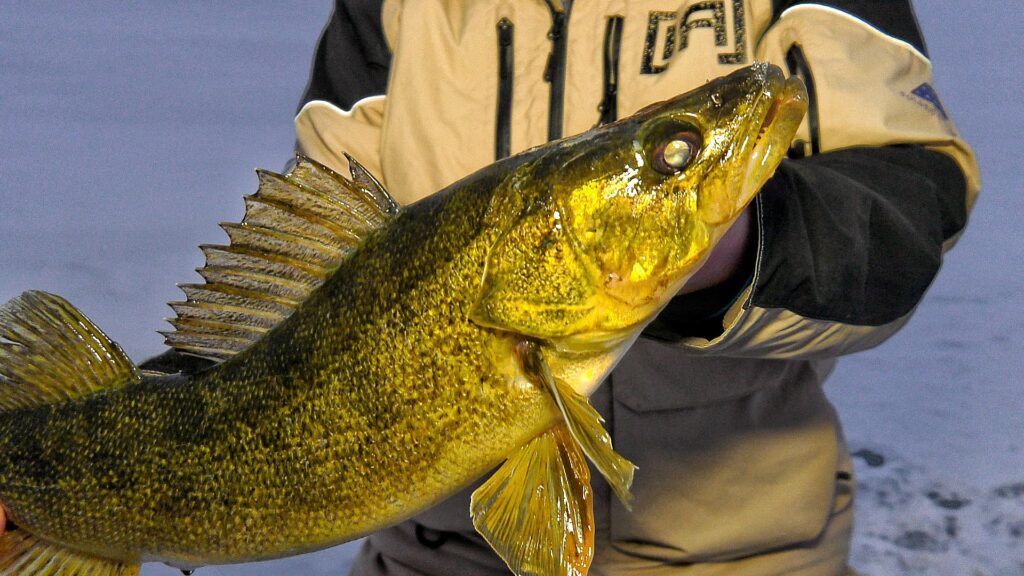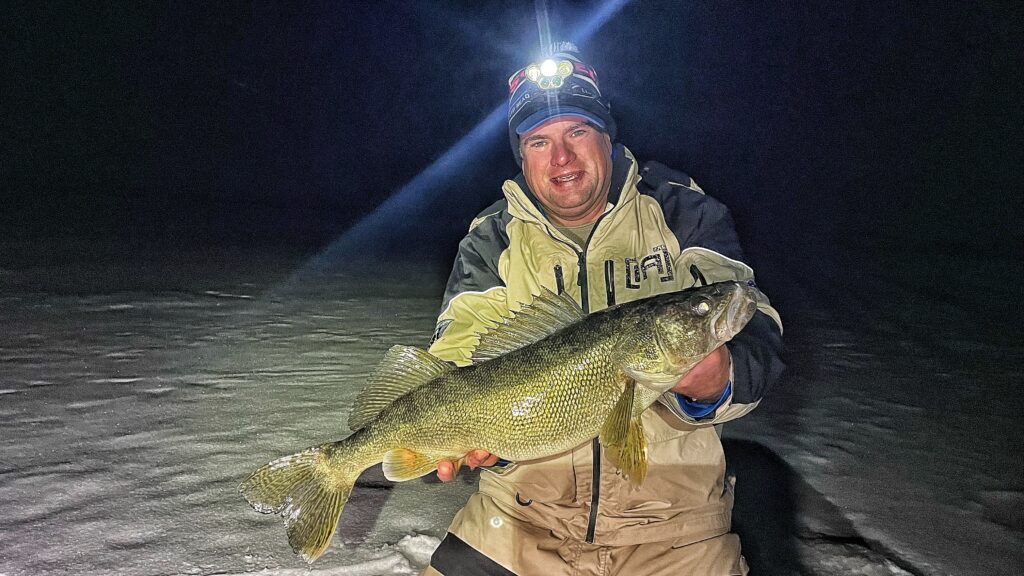On many lakes and reservoirs, the early ice time frame is one of the best periods for catching walleye through the ice. In many ways, the early ice period is a continuation of fall fishing. For simply connecting the dots and landing on walleye right away at early ice, one of the very best strategies is simply focusing on some of the best locations or lakes that were productive in the fall. Breaking down location even further, some of our favorite early ice locations fall into a handful of characteristics. Below is a cheat code for some of our favorite locations along with some additional tips and strategy for catching more walleye this winter at early ice.
Table of Contents:
Best Locations for Early Ice Walleye

Ice safety and ice thickness has a huge bearing on early ice locations. Many of our favorite locations are simply a matter of logistics… locations that we can safely reach at early ice particularly when required to walk out and pull your gear out on foot. Because of logistics, many of these types of spots are simply spots that are shoreline related that we could reach on foot.
Break Lines in Front of Light Current
On many natural lakes, one of the very best locations is in front of an incoming small creek or inflow. Typically, there is often a large sand flat in front of these small creeks or inflow that connects to another lake. The first sharp break in front of this flat adjacent to this trickle of current is a prime location at early ice.
Biggest Points and Shoreline Flats
There is usually no shortage of flats or points that protrude off a typical shoreline. At early ice, look for the big pieces of obvious structure. The most prominent point or largest flat is often prime before the crowds at early ice. On large shallow flats, look for the first mid-depth stair step or break line that drops off into deeper water. After dark, don’t be afraid to look shallow on the flat itself in closer proximity to the deeper water. Large prominent points offer a lot of options as you can follow fish from deep to shallow as the day progresses.
Hard Edges

On lakes that are prominently a soft bottom or sand, rock locations in the shallow to mid-depth range can hold a lot of walleye at early ice. On many lakes we fish, these rocks might be in five to 22 feet of water. Sometimes these rocks might coincide with a piece of structure like a small hump connected to the shoreline via a saddle. Could be a point. Might be a patch of rock on a flat. When rocks are relatively scarce, look for these rock locations at early ice. Finetuning these locations even further, the edges or transitions are often the spot on the spot. The outside edge or deep edge of rocks are often the sweet spot.
Secondary Points at Tributary Mouths
On larger reservoirs that have different arms and tributaries, these secondary points that occur near the mouth of the tributary up to halfway back into the tributary often hold a lot of walleye at early ice. Not to say that there are not walleye on primary points or relating to the primary channel on larger walleye at early ice but ice thickness often takes longer to develop. The tributaries typically freeze over first and these secondary points within these tributaries are often important for catching fish.
Tactics for First Ice Walleye Success

Tactics at early ice can have some notable nuances compared to the rest of the winter. Most notable is that these fish haven’t been touched by fishing pressure for a significant period of time and the fish are fresh. These early ice walleye are typically much more aggressive. Aggressively jigging glide baits and spoons often becomes extremely productive. On many fisheries, there is a natural progression where fish respond well to jigging hard baits and spoons particularly at low light or during prime-time windows. As the winter progresses, we often have to tone down the progression into midwinter where we have to fish with more subtle presentations by using more dead sticks and downsizing.
Favorite lures include classic glide baits like Jigging Raps, Tikka Minnows or Psycho Shads or Ripping Raps. Top spoons include Rattling PT Spoons, Leech Flutter Spoons, Ribbon Flutter Spoons and Buckshot Rattle Spoons. Flutter spoons in particular are often deadly in clear and shallow water. Rattle spoons get the nod in stained water or after dark.
While aggressively working lures is important, what can also be extremely important is additional set lines. Factors include the simple fact that we might not be able to hit several spots in a short amount of time because we are often walking out on the ice. The other factor is that walleye are often much spookier at early ice. Walking and noise scatters fish. Setting up tip ups or setlines like a Clam Predator or iFish Pro enable more lines in the water and can become extremely productive when walleyes are simply spooky.
In states and provinces where we can use multiple lines particularly when we are fishing with multiple anglers, these extra rods spread out in an area are beneficial because our activity above the ice will often move fish around us and away from us which often means these remote extra lines encounter more fish.
For smaller minnows like fatheads, rainbow dace and small to medium size shiners, I am a big fan of a remote set line like a Clam Predator as they are the most rugged and durable platform I have used. These set line platforms, however, do take up room especially when you consider the need for additional rods. This can be an issue at early ice when you are dragging a small sled. Because of logistics at early ice, I often lean more on tip ups.
For big shiners or small to medium size sucker minnows (which are extremely deadly) I always lean towards tip ups. Typically, I like a tip up with an indicator light when fishing after dark and also like to use hole covers to prohibit freeze up. Finicky Fooler makes a great hole cover for tip ups. We also developed a premium high-end tip designed specifically for walleye fishing called the Clam Watch Tower which has a large built-in light which you can change colors to color code bait size or assign to an angler. This tip up also has a molded hole cover. We designed this tip up to assimilate all the pieces we needed into one contained unit to save room and additional pieces to lose. Four of these tip ups will fit in a five-gallon bucket where before… we needed more space to haul tip ups and hole covers not to mention we were always loosing clip on tip up lights.
Spreading out tip ups across shallow shoreline structure after dark is one of the deadliest ways to simply catch walleye on many fisheries after dark at early ice.
Dealing with the Early Ice Spook Factor

I cannot stress enough how spooky walleye can be on three to seven inches of ice. Especially clear ice over clear water, these fish will move from your presence. On many fisheries, prime time is around sunset or shortly after dark. Get out ahead of time and drill your holes so the spot can settle down. Also important… drill as few of holes as possible to fish the spot. We often wear ice cleats for walking on the ice and dragging our sleds or Fish Traps and ice cleats are an important safety item, but ice cleats do make a lot more noise. I often take off my ice cleats when I get to the spot and start fishing. Dragging anything on the ice also creates a lot of noise. Get to your spot early and wait and sit. Be conscience of noise and keep your noise to a minimum. In extremely shallow water, light can also spook fish and that might be part of the reason why tip ups can be so deadly at early ice in shallow water after dark.
Early ice is one of the most rewarding—and most overlooked—times to target walleye. With the right locations, smart lure selection, and an awareness of how easily early-season fish can spook, you’ll set yourself up for consistent success as winter begins. Whether you’re walking out on first ice or planning multiple trips throughout the season, applying these strategies will help you stay on fish and stay safe.
For more tips, techniques, and seasonal insights, explore our full ice fishing archive to continue sharpening your skills all winter long.



